How Different Generations Use Social Media

How Different Generations Use Social Media
Trends in how generations use social media channels correlate with the types of content people prefer and what people hope to gain from online interactions. Social media users across generations are drawn to visual content such as images and videos. This has led to growth in visually driven platforms such as YouTube, Instagram, and Snapchat, especially among younger generations.
Although people tend to think of social media in terms of Facebook, Instagram, and Twitter, the reality of the social media landscape is much more diverse. Other platforms such as YouTube, Pinterest, and, to a lesser extent, LinkedIn and Reddit are still popular but not among every generation.
As a whole, younger generations such as Generation Zers (ages 13-17), millennials (ages 18-34), and Generation Xers (ages 35-54) use social media more frequently than baby boomers (ages 55+). However, this is not the case for every social media channel.
Different generations are drawn to different social media platforms that correlate with the types of content people prefer and what they hope to gain from their time online.
The Manifest surveyed 627 social media users from across the U.S. to understand how social media use varies across generations and what types of content fuel their social media habits.
Businesses can use this report to better understand their consumers’ social media habits and what types of content on which platforms might appeal most to their target audience.
Our Findings
- More than 80% of every generation uses social media at least once per day making social media part of their daily routine.
- The majority of Generation Zers (77%) and millennials (79%) use social media multiple times a day, but millennials are more likely to divide their time across a wider range of platforms, while Generation Zers spend more time on fewer platforms.
- Images remain the most popular type of content: Around three-quarters of Generation Zers (77%), millennials (77%), and Generation Xers (72%), along with 52% of baby boomers, prefer posting images on social media.
- Facebook’s popularity is declining with younger generations with only 36% of Generation Zers use Facebook at least once a week, compared to 87% of millennials, 90% of Generation Xers, and 96% of baby boomers.
- The majority of Generation Zers (89%), millennials (86%), Generation Xers (68%), and baby boomers (52%) use YouTube at least once a week to access video content.
Social Media Is Part of Every Generation’s Daily Routine for Different Reasons
Social media was once associated with only the younger generations, but now, all generations use social media as part of their daily routines.
More than 80% of every generation uses social media at least once per day.
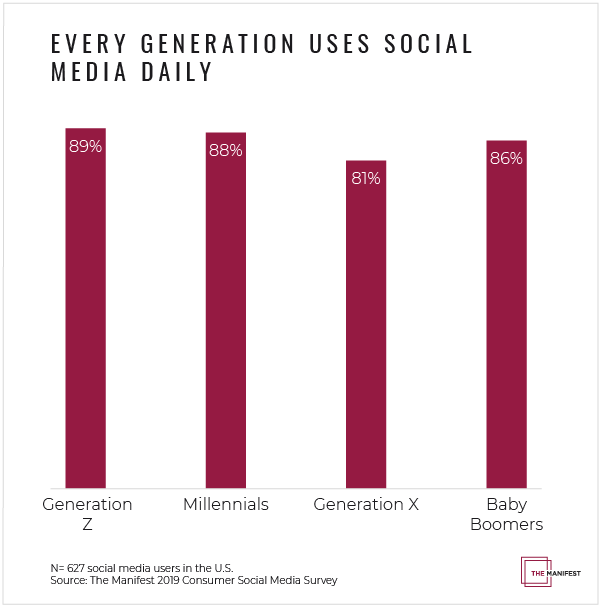
Eighty-nine percent (89%) of Generation Zers, 88% of millennials, 81% of Generation Xers, and 86% of baby boomers use social media daily, but why? Easy access to the internet and mobile devices is one reason.
“Our daily use of social media reflects what is happening culturally with mobile devices and everyone having such easy internet access,” said Nicole Rados, social media director at Convertiv, a digital marketing agency. “Social media is such an easy way to get in touch with people, follow the news, and just stay up-to-date on culture and events.”
What people hope to gain from their experience online drives their social media habits, and people use different platforms for various reasons such as:
- Staying in touch with friends and family
- Finding a sense of community
- Searching for solutions to problems or information
- Looking for ideas or inspiration
- Entertainment
- Promoting professional endeavors
- Expanding professional network
Ultimately, people’s social media habits are shaped by their individual preferences and interests, which are also influenced by their age and generation but not always.
“I’m a millennial, but so is my fiancé, and we both use social media very differently,” said Anastasia Iliou, senior content manager at MedicarePlanFinder.com. “I'm more of a Facebook user … My fiancé, on the other hand, pretty much exclusively uses Reddit. I genuinely believe that preferred social media platforms have nothing to do with age and everything to do with personality.”
I genuinely believe that preferred social media platforms have nothing to do with age and everything to do with personality.
Discussing social media habits among generations is less about generalizing generational habits and more about thinking critically about the age of the generations, where they are in life, and what they hope to gain from their social media experience.
“Social media is driven by the interests of [a] specific individual,” said Mark McIntyre, CEO of MaxAudience, a San Diego advertising and web design agency. “You just look at the generation, and each generation has a different personality … [but] you don’t think about it as just the generational personality. You also have to layer on the age of the folks in that generation.”
Social media habits are driven by people’s individual interests, but their age can play a role in which channels they are drawn to.
For example, a baby boomer may turn to Facebook to interact with others, while a Generation Zer may turn to Snapchat.
“I use Facebook daily because so many of my peers and older friends use Facebook, and I like to catch up on [updates],” said Catherine Callahan, a baby boomer social media user, health advocate, and owner of ICareHealthCare, a home health care agency in Santa Barbara, California.
Like many other baby boomers, Callahan uses primarily Facebook to interact with others because that’s where her community is and where her target audience consumes content the most.
Callahan posts content related to health care to share information and tips with people searching for answers. She also uses Facebook to promote ICareHealthCare to those looking for in-home care.

As a baby boomer, Callahan not only uses Facebook but also Instagram, Pinterest, Reddit, Twitter, and YouTube. However, she uses Facebook the most since that’s where her community and target audience is.
Different needs and goals fuel each individual’s daily social media habits.
Generation Zers Spend More Time on Fewer Platforms Compared to Millennials
Generation Zers (ages 13-17) and millennials (ages 18-34) use social media more often than older generations, but even younger generations’ social media habits differ.
Although more than three-fourths of Generation Zers (77%) and millennials (79%) use social media multiple times per day, Generation Zers tend to spend more time on fewer platforms, while millennials tend to use a more diverse range of platforms.
At least 40% of Generation Zers report using three platforms at least once a week: YouTube (89%), Instagram (74%), and Snapchat (68%).
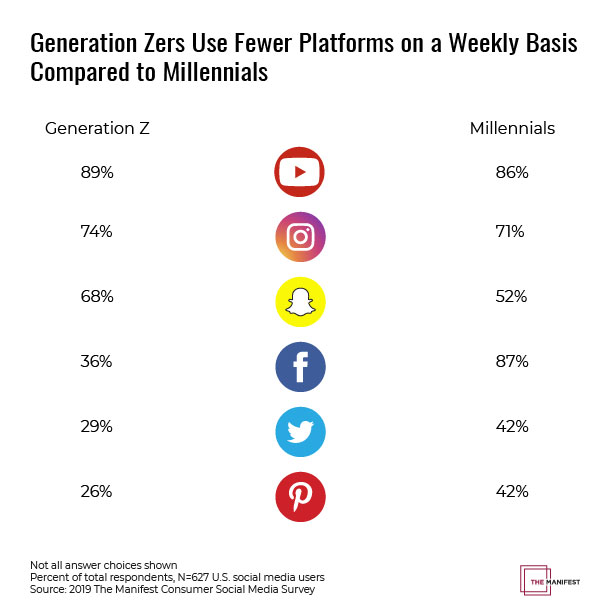
Conversely, at least 40% of millennials report using six platforms at least once a week: Facebook (87%), YouTube (86%), Instagram (71%), Snapchat (52%), Twitter (42%), and Pinterest (42%).
Generation Zers and millennials spend similar amounts of time on social media but use that time differently. Generation Zers focus on fewer platforms while millennials tend to use a greater variety of social media channels.
“Gen Zers are more targeted and know exactly what they want out of their social media use,” said Joseph Rothstein, CEO of Social Media 55, a social media marketing agency. “They don’t have the time to diversify the platforms they use because they’re focused on mastering the ones they use.”
While millennials divide their time across multiple platforms, Generation Zers focus more on mastering the platforms where their community exists.
Differences in how millennials and Generation Zers use social media may become more obvious as they both age and new platforms appear on the digital landscape, such as TikTok and Fortnite.
Facebook’s Popularity Is Receding With Younger Generations
Facebook is often hailed as the king of social media success, but its reign might one day come to an end if Generation Zers’ use of the platform is any indication.
Only 36% of Generation Zers use Facebook at least once a week, compared to 87% of millennials, 90% of Generation Xers, and 96% of baby boomers.
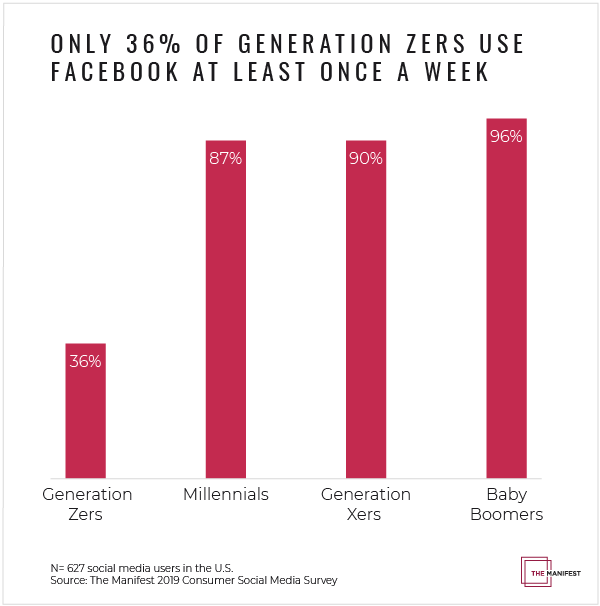
Baby boomers and Generation Xers report using Facebook most frequently, followed by millennials and then Generation Zers.
This gap signals Facebook’s declining popularity with younger generations.
“Facebook came out with a Gen X and millennial age group when it hit its peak in terms of users joining at a fast rate,” Rados said. “A lot of older people in the past [few] years have made up the majority of the newly joined user base on Facebook, and Generation Z wants to have its own network and place to engage with their friends that isn’t part of the older adult population.”
Although the age group of Facebook’s user base might be deterring younger generations, so might the type of content Facebook specializes in. Content on Facebook tends to be diverse, ranging from text-based to highly visual.
Some experts say this deters younger generations, who tend to only want to see content they are interested in.
“Snapchat and Instagram are cooler for younger generations because they have less content,” McIntyre said. “You get to choose to see all the good stuff and none of the junk. It’s way more image-based and way less text-based, and you don’t get everyone’s rant.”
Platforms such as Snapchat and Instagram appeal more to younger generations because they’re newer, tend to have a younger user base, and specialize in visual content, including short-lived content.
More than two-thirds of Generation Zers (68%) and 52% of millennials use Snapchat at least once a week compared to only 32% of Generation Xers and 5% of baby boomers.
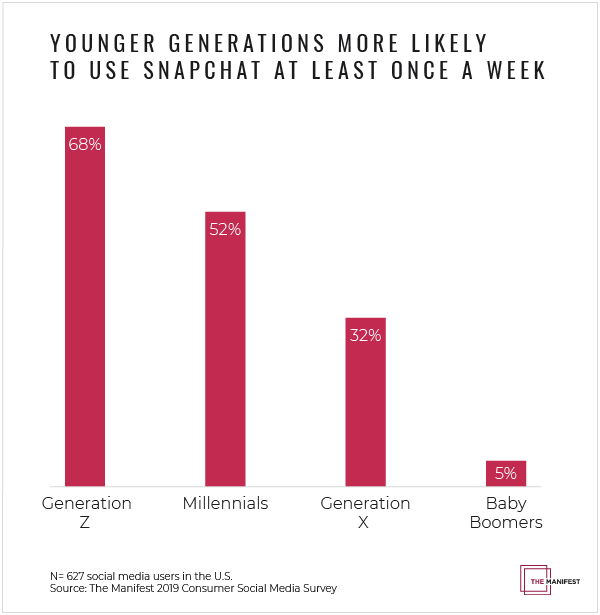
Snapchat allows users to share and see only the content they want to see, giving them more control over their privacy.
Facebook’s declining popularity with younger generations may also be linked to its recent data scandals.
“Younger generations are shifting back from everyone sharing everything on the internet,” Rados said. “It seems younger generations are wanting to be more closed off and have their private groups … with Snapchat specifically, they can select which friends see content and have smaller groups within the platform itself.”
Snapchat allows users a private experience contained to their own network, but it also gives users the option of connecting with others around the globe. Snapchat’s heat map features allow people to see where the most “snaps” are taken in a specific location.
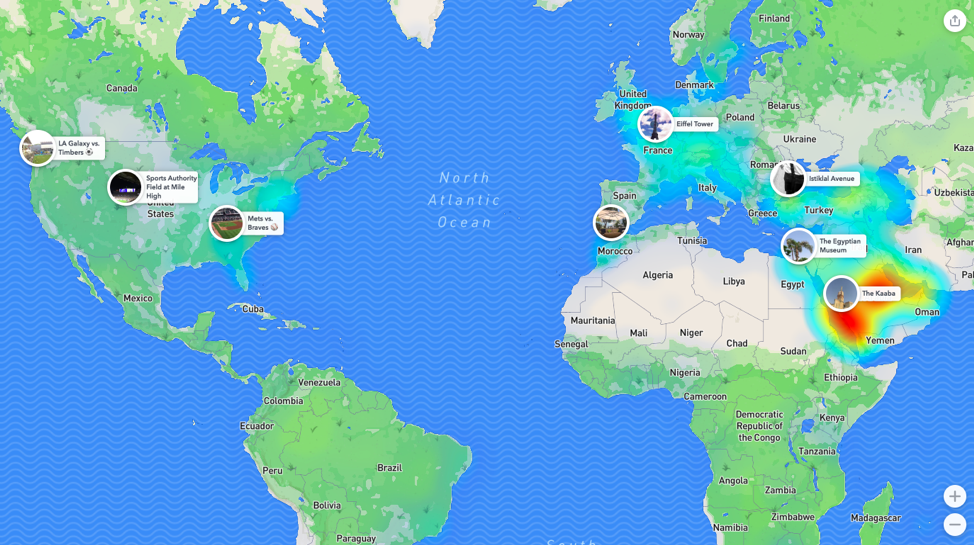
Snapchat users can see the different sports events trending in the U.S., watch snaps from the Kaaba in Saudi Arabia, and view photos and videos from the Eiffel Tower.
“I used [the heat map] as a guide to find the most popular areas to visit while traveling,” said Morgan Lathaen, a millennial social media user and marketing coordinator at Thumbprint, a branding agency. “I’ve also used it traveling to see where various monuments were based on my location.”
Like Facebook, Snapchat is a versatile platform, but it allows its users more control over the content they see and when they see it.
Facebook has been the king of social media for a while, and although it remains the most-used platform, this may change in the future in light of younger generations’ increased attention to privacy and content preferences.
All Generations Prefer Posting Images
People of all generations are visually driven and tend to post images more than other types of content.
More than 70% of Generation Zers (77%), millennials (77%), and Generation Xers (72%) prefer posting images.

Fifty-two percent (52%) of baby boomers also prefer posting images compared to other types of content such as updates, quotes, and opinions.
Lisa Dorenfest, a baby boomer, social media user, and circumnavigating sailor, said people prefer image content on social media because a good photo transports a viewer directly into the scene, stimulating the senses and generating a range of emotions.
“Words take more time to generate the same response effectively,” Dorenfest said.
Dorenfest uses mainly Instagram to share her photography from around the world.

Dorenfest’s images tell stories that she usually lets readers discern for themselves.
Posting images of her travels not only helps her connect with her audience but also helps her audience connect with places and cultures they may not ever experience themselves.
“Imagery tells a story that we can all fill in,” said Jeremy Graves, CEO of Jeremy Graves Coaching and Consulting LLC which helps businesses with strategy and culture. “We don't have to read what someone else thinks. We can connect through imagery, and the story becomes our own instead of having to read someone else's script.”
We can connect through imagery, and the story becomes our own instead of having to read someone else's script.
Images enable viewers to connect with scenes they’ve never seen in person.
They transport them to that moment while encouraging them to use their imagination to fill in the details that might not be reflected in the photo itself.
The Popularity of Visually-Driven Platforms Boosts the Influencer Market
The popularity of images and platforms such as Instagram has also given rise to social media influencers and influencer marketing.
For example, Dustin Tyler is a millennial social media influencer and tattoo model who uses his social media presence to promote products such as watches.

With more than 70K followers on Instagram, Tyler partners with companies to act as a brand ambassador and promote their products to his followers.
“Basically, I get paid to create content for certain companies and show that content to my audience and followers,” Tyler said. “I know the content I created on social media was successful if my followers purchased the products I promoted.”
Currently, Tyler relies on images but recognizes that video content can expand his network and open new opportunities for him as an influencer.
The power of images combined with the power of social media connects people to destinations and businesses through individuals’ content.
YouTube Attracts Users of All Ages
Video content is also popular among all generations, and as the demand for video rises, so does the popularity of the platforms that support it – especially YouTube
More than 80% of Generation Zers (89%) and millennials (86%) use YouTube at least once a week.
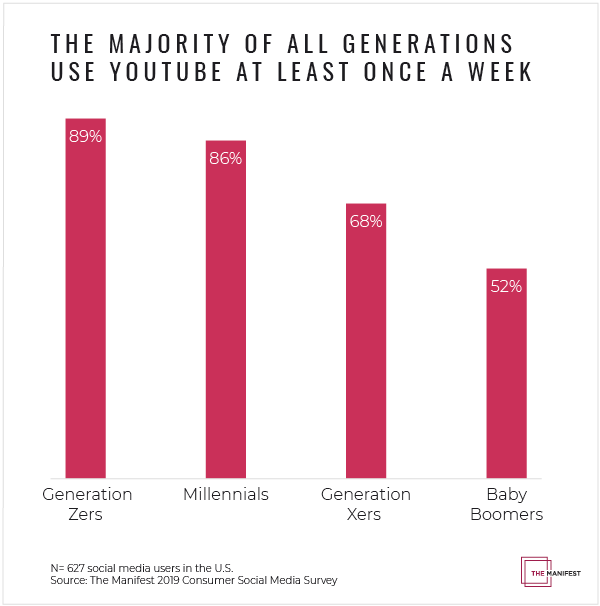
More than half of Generation Xers (68%) and baby boomers (52%) also use YouTube weekly, signaling an increasing popularity in video content across generations.
While images can transport viewers to the scene by sight, video can engage more of their senses by showing them what the scene looked and sounded like.
“Video content is the richest form of visual content,” Rothstein said. “Video leaves an impression on you. It allows you not only to remember the sounds but also the sights.”
Video leaves an impression on you. It allows you not only to remember the sounds but also the sights.
Video content is versatile in that it gives social media users options to:
- Watch and listen
- Watch with no sound
- Listen only to the audio
This versatility bodes well with an increasingly busy audience that appreciates the option to watch and listen, only watch, or only listen to a video, whether they’re on YouTube for entertainment or looking for information.
For example, Jim Costa is a Generation X social media user and runs a video blog dedicated to helping senior citizens learn how to use technology to accomplish everyday tasks.
“I focus on senior citizens because while I’m fortunate enough to understand technology, I realize that many seniors aren’t, so I do what I can to help,” Costa said.
His series on Google Chrome, for example, helps senior citizens learn how to perform tasks such as tracking packages using Chrome so they can live more independent lives.
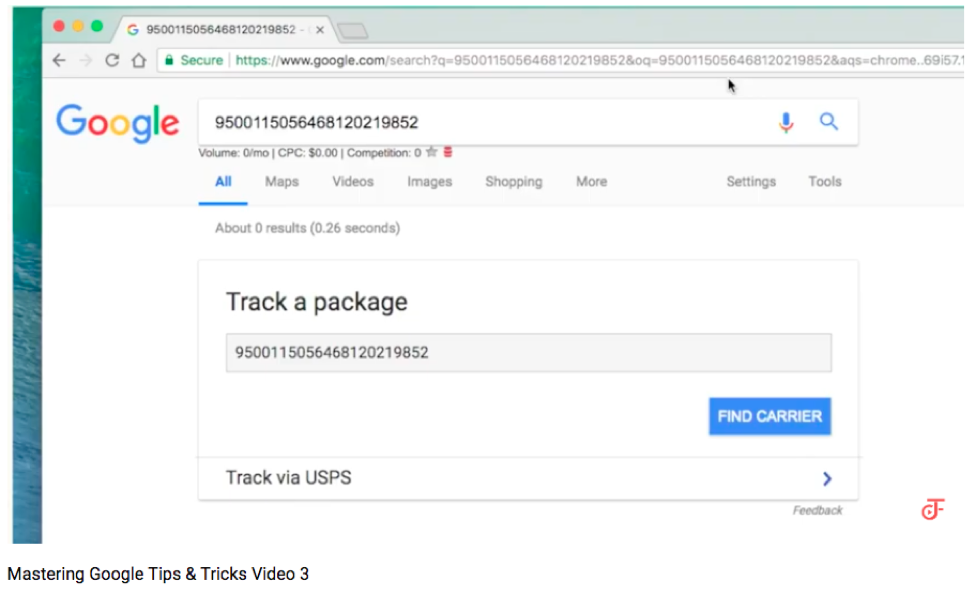
Other videos he produces explain how to download apps, offer iPhone tips, and discuss the meaning behind emojis – things that might seem second nature to younger generations but prove challenging to older social media users.
Video content’s accessibility makes it one of the richest content types. Demand in video content has given rise to YouTube, especially among younger generations, and incentivized other platforms to cater their channels more toward video content, including short-lived content platforms such as Snapchat and Instagram stories.
Content Preferences Fuel Generational Social Media Habits
Most marketers and social media marketing agencies are aware that generations have different habits when it comes to social media. However, as generations age and new types of content are introduced to the social media landscape, marketers and businesses will need to stay up to date on the latest social media trends.
- In 2019, more baby boomers are using Facebook weekly than Generation Xers, millennials, and Generation Zers.
- Younger generations such as Generation Zers and millennials are more drawn to visually-driven platforms such as Instagram and Snapchat.
- Every generation prefers posting images more than other types of content such as updates, opinions, and even video.
- The majority of every generation use YouTube at least once a week.
Although people’s generation plays a role in determining which platforms they use, content preferences and what individuals hope to gain from their time online play a larger role in determining their social media habits.
About the Survey
The Manifest surveyed 627 social media users in the U.S.
Most survey respondents were female (65%), and 35% were male.
About 14% of respondents are Generation Zers (ages 13-17); 36% are millennials (ages 18-34); 31% are Generation Xers (ages 35-54); and 19% are baby boomers and older (ages 55+).

